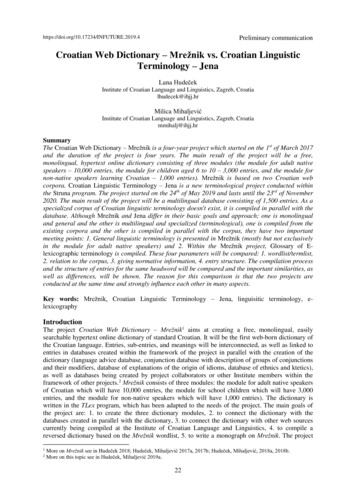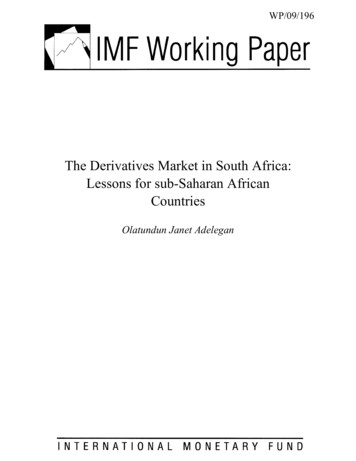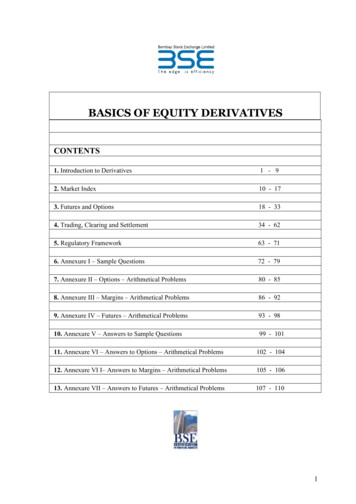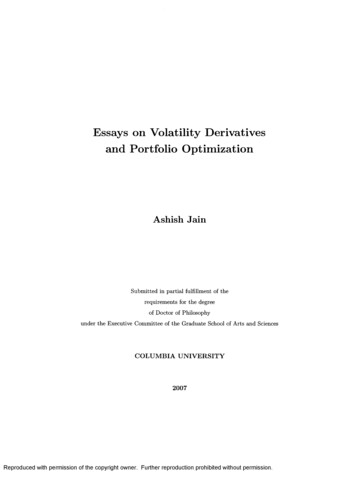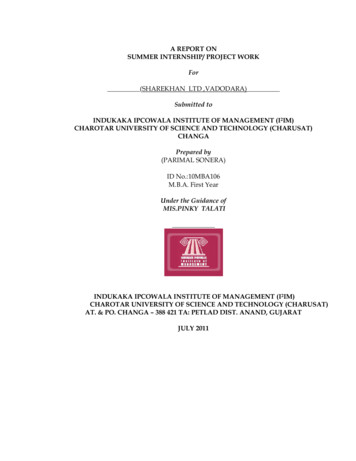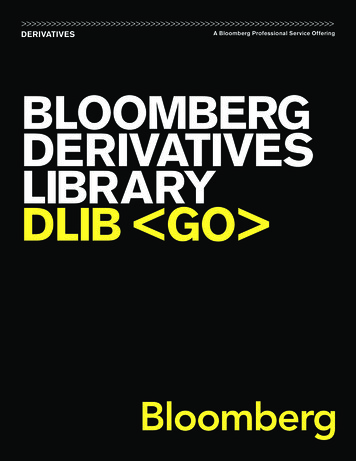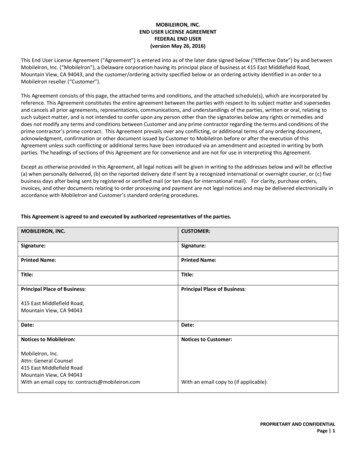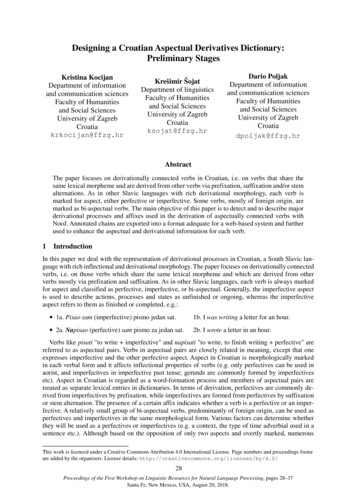
Transcription
Designing a Croatian Aspectual Derivatives Dictionary:Preliminary StagesKristina KocijanDepartment of informationand communication sciencesFaculty of Humanitiesand Social SciencesUniversity of ZagrebCroatiakrkocijan@ffzg.hrKrešimir ŠojatDepartment of linguisticsFaculty of Humanitiesand Social SciencesUniversity of ZagrebCroatiaksojat@ffzg.hrDario PoljakDepartment of informationand communication sciencesFaculty of Humanitiesand Social SciencesUniversity of ZagrebCroatiadpoljak@ffzg.hrAbstractThe paper focuses on derivationally connected verbs in Croatian, i.e. on verbs that share thesame lexical morpheme and are derived from other verbs via prefixation, suffixation and/or stemalternations. As in other Slavic languages with rich derivational morphology, each verb ismarked for aspect, either perfective or imperfective. Some verbs, mostly of foreign origin, aremarked as bi-aspectual verbs. The main objective of this paper is to detect and to describe majorderivational processes and affixes used in the derivation of aspectually connected verbs withNooJ. Annotated chains are exported into a format adequate for a web-based system and furtherused to enhance the aspectual and derivational information for each verb.1Introduction*In this paper we deal with the representation of derivational processes in Croatian, a South Slavic language with rich inflectional and derivational morphology. The paper focuses on derivationally connectedverbs, i.e. on those verbs which share the same lexical morpheme and which are derived from otherverbs mostly via prefixation and suffixation. As in other Slavic languages, each verb is always markedfor aspect and classified as perfective, imperfective, or bi-aspectual. Generally, the imperfective aspectis used to describe actions, processes and states as unfinished or ongoing, whereas the imperfectiveaspect refers to them as finished or completed, e.g.: 1a. Pisao sam (imperfective) pismo jedan sat.1b. I was writing a letter for an hour. 2a. Napisao (perfective) sam pismo za jedan sat.2b. I wrote a letter in an hour.Verbs like pisati "to write imperfective" and napisati "to write, to finish writing perfective" arereferred to as aspectual pairs. Verbs in aspectual pairs are closely related in meaning, except that oneexpresses imperfective and the other perfective aspect. Aspect in Croatian is morphologically markedin each verbal form and it affects inflectional properties of verbs (e.g. only perfectives can be used inaorist, and imperfectives in imperfective past tense; gerunds are commonly formed by imperfectivesetc). Aspect in Croatian is regarded as a word-formation process and members of aspectual pairs aretreated as separate lexical entries in dictionaries. In terms of derivation, perfectives are commonly derived from imperfectives by prefixation, while imperfectives are formed from perfectives by suffixationor stem alternation. The presence of a certain affix indicates whether a verb is a perfective or an imperfective. A relatively small group of bi-aspectual verbs, predominantly of foreign origin, can be used asperfectives and imperfectives in the same morphological form. Various factors can determine whetherthey will be used as a perfectives or imperfectives (e.g. a context, the type of time adverbial used in asentence etc.). Although based on the opposition of only two aspects and overtly marked, numerousThis work is licenced under a Creative Commons Attribution 4.0 International License. Page numbers and proceedings footerare added by the organizers. License details: edings of the First Workshop on Linguistic Resources for Natural Language Processing, pages 28–37Santa Fe, New Mexico, USA, August 20, 2018.
studies in the area of second language acquisition indicate that aspect is one of the most complicatedcategory for learners of Slavic languages.In this paper we present preliminary stages in the construction of the database of Croatian aspectuallyand derivationally connected verbs, i.e. aspectual derivatives. Apart from its potential pedagogical use,the database of aspectual derivatives is one of the first attempts to systematically present this area ofCroatian derivational morphology. The paper is structured as follows: In Section 2, we briefly describemajor derivational processes in Croatian and focus on the derivation of verbs from other verbs andaspectual changes that take place. Sections 3 and 4 present the processing of aspectual derivatives inCroatian in NooJ and provide an overview of underlying principles. In Section 5, the design and thestructure of the database is discussed. The paper concludes with an outline of future work.2Derivation of verbsMajor word-formation processes in Croatian are derivation and compounding. Further we discuss onlyderivation which predominantly consists of affixation. Although there are some other processes likeconversion or back formation, they are not as prominent as prefixation or suffixation (Šojat et al, 2013).Croatian verbs can be thus divided into simple imperfectives (pisati "to write imperfective") andprefixed perfectives (na-pisati "to write perfective") denoting that the action is completed. Other prefixes used for the derivation of perfectives add different semantic features (pisati "to write imperfective" – pre-pisati "to copy by writing perfective" – pot-pisati "to sign perfective") and enable furtherderivation, either through prefixation, suffixation or simultaneous prefixation and suffixation. Theseperfectives can be derived into secondary imperfectives denoting iterative actions through suffixation(potpis-ivati "to sign several / many times"). Other suffixes are used for the derivation of diminutiveverbs (e.g. pisati– pis-karati "to scribble imperfective") or verbs expressing punctual actions (vikati"to shout imperfective" – viknuti "to shout once perfective"). Further, some secondary imperfectivesare derived via prefixation into perfectives denoting distributive actions (is-potpisivati – "to sign eachone perfective", e.g. each letter, every document etc.). In some cases aspectual distinctions are expressed by vowel variations or suppletive forms (e.g. doći "to come perfective" – dolaziti "to come imperfective"). Detailed account of morpho-semantic relations among Croatian verbal derivatives isfound in Šojat et al. (2012).In the following section we show how existing language resources can benefit from the informationabout verbal aspect in terms of their extension and enrichment. We demonstrate this on the inflectionaldictionary for Croatian verbs in NooJ.3Verbs in NooJ DictionaryThe main language resources (LR) for Croatian, as prepared in Vučković (2009) and explained inVučković et al. (2010), include the dictionary of Croatian verbs. Each verb was originally marked forthe main category V , reflexive property V Prelaz pov and a paradigm rule FLX responsible fordescribing the rules used to build all the simple verb forms,1 for example:pisati,V FLX PISATIasistirati,V FLX SJATIsjati,V Prelaz pov FLX SJATI“to write”“to assist”“to shine”.In all cases, a name of a verb is used as a representative of a specific conjugation paradigm. Forexample, the verb sjati “to shine” uses the set of conjugation rules that we refer to as SJATI FLX SJATI . All the other verbs that share the same set of conjugation rules will be associated withthis name of the paradigm like the verb asistirati "to assist." In addition to these three markers, a smallsubset of verbs was also marked for valency (Vučković et al., 2010) to improve the performance of theCroatian chunker and some verbs were marked for aspect.Although each Croatian verb has an aspect by its nature, either perfective, imperfective or bi-aspectual, this information was not originally encoded into the main dictionary entries. This is mainly due to1Complex tenses in Croatian such as future I and II, perfect, pluperfect, or conditionals are described within syntax grammars and are beyond the scope of this paper.29
the absence of that information in the resources built after the MULTEXT-East specifications preparedby Tadić, as explained in Erjavec (2001), from which NooJ resources have been adopted.There are 4,168 main verb entries in the NooJ Croatian dictionary. At the beginning of our project,there were only 1,448 verbs that had been marked as either perfective Aspect perf , imperfective Aspect imperf or bi-aspectual Aspect bi regarding the Category of aspect (Table 1). This meansthat little over 65% of verbs had no marker assigned for this category.Total perf imperf bino marker4,1686735342412,720Table 1: Original distribution of Aspect markersThe importance of information on aspect encoded in the verb, lies, among others, in the list of possibleverbal forms. For example, only perfective verbs can have aorist past tense and past adverbial participleforms, while only imperfective verbs can have the imperfect past tense and the present adverbial participle. Before we could add the tag for aspect automatically to the remaining verbs, it was important tocheck if the existing aspect markers were correctly assigned and what data could be used to correctlymark the remaining 65% of verbs. Since the list of possible tenses is embedded into the conjugationparadigms (FLX), we decided to start our investigation with them.3.1Data Analysis of the original dictionaryAt the very beginning of our analysis, we found two paradigms that were using both Aorist and Imperfectendings [FLX POKLONITI and FLX BIRATIDODATI]. Two does not sound like a large number, butif we take into account that the POKLONITI paradigm is responsible for the conjugation of 106 verbsand the BIRATIDODATI paradigm for 204, we are not talking small numbers any more. We proceededwith the analysis by double-checking each of the 310 verbs. We learned that all the verbs using thePOKLONITI paradigm are actually perfective in aspect (as is the paradigm itself), while the other verbsare all dual which makes the presence of aorist and imperfect endings appropriate. Thus, we were ableto annotate these verbs with appropriate markers Aspect perf and Aspect bi , respectively. In addition, we revisited the POKLONITI paradigm and removed the endings for Imperfect. At this point, wealso decided to recheck the aspect category of all the verbs.To avoid individual checking each verb, we cross referenced all of the assigned aspects with the aspectof a verb used to mark the conjugation paradigm. From that list (Table 2), after removing all the verbswhose aspect matched the aspect of a paradigm, and all the verbs that had no aspect defined, we wereleft with only 62 verbs that had been marked as mismatched and that needed to be checked manually.Since the reason for the mismatched aspect could be due to either an incorrectly marked aspect of averb or to an incorrectly described paradigm, we checked both, starting with the verbs. Paradigm analysis revealed some missing aorist and/or past participle descriptions in the category of perfective verbs,and missing imperfect and/or present participle descriptions of imperfective verbs. Also, some descriptions of bi-aspectuals were missing, either aorist and past participle descriptions, or imperfect and present participle descriptions. All of these cases were corrected to mirror the related aspect, either by correcting the value of an Aspect attribute or changing the paradigm name.For the final analysis we wanted to make sure that there are no duplicates among our paradigms, i.e.that we do not have different paradigm names describing the same conjugation occurrences. We detected16 such occurrences that we have replaced choosing the one paradigm that was used more often in thedictionary.3.2The new verb dictionary and paradigmsThere are 209 paradigms that describe the conjugation rules for Croatian verbs. Some rules describeonly one verb in a dictionary (there are 67 such rules), while others describe more (Figure 1). The largestnumber of verbs (538) described by the same paradigm BIRATI make up 13% of all the verbs in thedictionary, while the second runner up (SJATI) describes 7% of verbs.30
FLXAspectFLXTable 2. Distribution of different aspects assigned to paradigmsFigure 1. Distribution of paradigms among Croatian verbsHowever, a closer look shows us that these descriptions are not as different as they might first appear.We will show this through a detailed analysis of simple verb forms by tense category, starting withpresent tense.What makes these paradigms different is the list of tenses they describe, but also how each tense isdescribed. These two categories (list of tenses, form of tenses) are linked by an OR operator, meaningthat the difference in either one or both from the existing list of paradigms, results in a new paradigm.To demonstrate, let us compare the UGOJITI and POKLONITI paradigms. They both have the samelist of tenses they can form (present, imperative, PDR - verbal adjective active, PDT - verbal adjectivepassive, aorist and GPP - past adverbial participle), but the way they make PDT differs [ B3 en(:PDT)and B3 jen(:PDT) respectfully] and thus they form different paradigm rules.31
However, since NooJ allows multiple usage of its grammars (Silberztein, 2016), each tense rule isdescribed as a separate sub-grammar and then called from a paradigm, where needed. In order to describe derivations of Croatian simple verb forms that are in the NooJ dictionary, we built 280 such subgrammars whose different combinations build 209 paradigms that describe 4,168 verbs and recognize377,603 forms, taking into account simple verb tenses (long/short infinitive, present, imperfect, aorist,passive/active verbal adjectives, imperative, present/past adverbial participles), gender (masculine, feminine, neutral), number (singular, plural) and person (1st, 2nd, 3rd).Figure 2. Distribution of sub-grammars per tenseAs expected, inside each tense category, some descriptions are more common than others. This distribution (Figure 2) is different for each of the tenses. The same is true for the number of rules whichranges from 15 (GPP) to 61 (Present). The number of paradigms that do not have rules for a tense aremarked in gray (for example: 2,153 paradigms do not have Imperfect, 2,079 do not have GPP, 2,015 donot have GPS etc.). Present is the only tense that is found in all paradigms.Figure 3. Distribution of Present rules used among existing verbsFigure 3 shows the distribution of rules2 used to build the present tense found in the existing 209paradigms. It may look as if there are 61 different suffixes for the Croatian present, but this is not thecase. Throughout the paradigms, the same set of suffixes is used for all three genders (male, female,neutral), for all three persons singular [-m, -š, -/], and for the first and second person plural [-mo, -te].The third person plural may have the ending [-e] or [-u]. So, why are there 61 different present tensedescriptions in this figure?Although the set of suffixes is the same (with two possible alterations for 3rd person plural), changesthat occur before the suffix differ. In some cases it is enough to only remove ( B2 ) the infinitive ending2Each circle represents one rule; the bigger the circle, the more verbs the rule describes.32
(-ti or –ći) and add the suffix, but in some cases more letters need to be removed ( B3 . B5 ) andmore letters prior to the suffix need to be added, like in the following examples:isteći - B2 če(:PRsingular) istečem [removes last 2 characters, inserts ‘če’ before adding suffix for Present]izleći - B2 že(:PRsingular) izležem [removes last 2 characters, inserts ‘že’ before adding suffix for Present]otprijeti - B5 e(:PRsingular) otprem [removes last 5 characters, inserts ‘e’ before adding suffix for Present].After removing duplicate verbs from the dictionary and sorting out the paradigm sets, we were ableto automatically add the missing aspect information for all unmarked verbs. Their total now amounts to4,134. The largest aspect category are perfective verbs, followed by imperfective verbs and bi-aspectualverbs. Their distribution is visualized in Figure 4.Figure 4. Distribution of verbs per aspect category in the dictionaryand number of paradigms used to describe each category4Grammar modeling for aspectual derivativesComputational derivation is a well-known process when new words need to be created in order to economically enlarge the dictionary (Trost, 2003). NooJ provides two routes to describe derivations.The first one uses a derivational module that allows a direct link between the dictionary with the listof words that can be derived and a grammar that provides rules for their derivation either graphically ina form of an enhanced recursive transition network (ERTN) or via formal grammar rules as context-freegrammar (CFG). This link is defined via an attribute DRV that holds the name of the paradigm responsible for the allowed derivation(s).The second one uses a morphological grammar module that may simulate the dictionary entries viaERTN. It can recognize a defined set of letters and tag them in the same manner that we would manuallydo in the dictionary. The difference is that in the grammar can have a few graphs describing multipledictionary entries (e.g. if we wanted to recognize and tag roman numerals, we can do it by a minimumof five graphs or by 3,999 dictionary entries).Since our main objective is to produce derivational paths in a format that we can use to populate theweb-based database, we have opted for the second approach that left us more room to accommodate theoutput to the database design (see Figure 5). To avoid recognizing words that start with the same set ofletters as prefixes used in derivations, we introduced the constraint that the dictionary check and validateif the primary verb first exists. So, for example, sufinancirati "co-finance" will be recognized, sincethere is a verb ‘financirati,V’ in the dictionary. On the other hand, the word suncobran “parasol” willnot be recognized, since there is no dictionary entry marked as ‘ncobran,V’ (nor any such word in Croatian).For the preliminary grammar model, we used all the derivations for the verb pisati “to write” (Table3a) and the verbs bacati / baciti “to throw away” (Table3b). All the pairs have both perfective and33
imperfective forms. This is not true in only two cases: for the derived form napisati that has no aspectualpair, and the aspectual pair ispotpisati - ispotpisivati that share the same aspect (perfective).3 If we putaside these two exceptions, from the remaining pairs we can conclude that if there is a verb in the dictionary to which a prefix is added, then the newly derived verb will be perfective in aspect. If a verbderived in such a manner adds the suffix2 (SUF 2), then the new verb will be imperfective in aspect ifthe length of suffix2 is 3 or 4 and perfective if its length is 0, 1 or 2.Table 3. Aspectual derivatives of the root verbsa) PISATI "to write" and b) BACATI / BACITI "to throw away"We have applied these rules to the morphological grammar built in NooJ. Figure 5 illustrates how thegrammar works, using the verb ispisivati “to write out.”Figure 5. Morphological grammar that recognizes and annotates a verb derived bya single prefixation and suffixation (example of the verb ispisivati)Possible prefixes in the first position (i.e. the position closest to the root), such as the prefix is, arelisted in the P1 node. The following node holds any set of letters which are recognized as the root ofthe verb used to build the constraints that check if such a root concatenated with a ti exists in thedictionary as a verb in infinitive form whose Aspect is defined as INF pis a ti :V INF inf . If thisconstraint is validated, we check against the length of suffix2. Since the length in our example is 3, weproceed with the path where @S2 LENGTH 3 . It then leads us to the annotation section that ads3This may be due to the fact that the verb ispotpisivati is actually derived from potpisivati, while the verb ispotpisati is redundant in semantical meaning of its prefixes i.e. the prefix is does not bring anything new to the meaning of pot in this context. In the hrWaC 2.2 web corpus (Ljubešić & Klubička, 2014) it shows up only 7 times, mostly in an informal web setting.34
the recognized lemma as the superlemma of the derived verb, and marks the POS, Root and Derivationalchain with the aspect marker for each derivation [ DERIV pisati inf- ispisati fin- ispisivati inf].This information is then exported from NooJ and added to the Specifics table of our web database asdiscussed in Section 5.In Table 3b, there is an imperfective verb BACATI "to throw away" from which the perfective verbnabacati "to throw onto" is derived by prefixation. Its imperfective pair is the verb nabacivati "to throwonto" derived via suffixation. The perfective verb BACITI uses prefixation to produce a perfective formnabaciti whose imperfective pair is also nabacivati. This means that the imperfective form nabacivatishould be found in both aspectual derivational chains. But, ambiguity is not a stranger to language.5Database and interface designAfter extracting data into usable chunks, we wanted to present it in a way usable to others. To reach thewidest possible audience with our tool, we focused on bringing it to the web. In that way it will beavailable to everyone with basic Internet access and can be dynamically updated as new chains areprepared within NooJ. However, to accomplish that, we needed to create a searchable interface backbonein a well-structured database, whose main function is to support our information system as defined inGunjal (2003).Due to the nature of our data, we decided to split it into three separate semantic data-groups (Figure6). The Main data set stores all the data at the morphological level that will be searchable through theonline tool, with various levels of granularity. The Specifics provides derivational data focusing on onemodel used for the derivation. The Examples set unifies all the semantics and should provide a betterunderstanding of the verb’s usage.Figure 6. Data structure of three data groupsSince we are using csv to represent our data, it is already in a rather structured state. Thus, our datacan be described as a structure in the first normal form. This means that the data itself can fit into tabularformat and that it always contains only one value for each cell. The first normal form also assumes theusage of primary keys for the unique representation of every row of data. This can be performed automatically while importing it into the database as described in Gilfillan (2015).As can be seen, there is still some redundant data (Figure 6) since the Main Data file contains bothForm and Root components, present in other files as well. The idea behind the interface is to allow usersto search either by Form or Root fields with additional (optional) Suffix and Prefix information, and thenconditionally showing examples and specifics depending on which Form is selected. Thus we can reducethe clutter in the other two files by imposing a foreign key constraint after importing it into our databaseand removing Form and Root information from the other two tables (since that data will already be inthe search results from querying the Main Data file).We used MySQL (Coulter, 2017) to store the data and created primary keys, as well as foreign keyconstraints. After importing all the data and imposing foreign key constraints, we are left with 3 tables(Figure 7) with almost identical structure as we had at the beginning (Figure 6). Now the Form and Rootfields are present exclusively in the Main Data table. In order to access it from other tables, we use theforeign key named mainID constrained to the ID field. It also acts as the primary key of our Main Datatable. The foreign key constraint is set up in a way that easily enables us to update or delete multiplerecords at once without ever leaving the Main Data table.35
Figure 7. Representation of tables and their data in the databaseFurthermore, a search is performed on only one (Main Data) table with all the additional informationretrieved only upon the user’s request. Figure 8 depicts one such instance when the verb form ispisivatiis selected for search.4 The derivational chain [Derivacija: pisati - ispisati - ispisivati] holds additionalinformation on aspect that is color-coded (perfective verbs are marked in red, imperfectives in blue) andavailable via a hover feature.ISPISIVATIFigure 8. Web interface showing additional information onderivation and examples for the verbs ispisivati6ConclusionIn this paper we showed some preliminary steps taken in the processing of Croatian aspectual pairs. Thisphase of the project consists of the extension of the existing verb dictionary and its enrichment with theinformation on verbal aspect. This preliminary step resulted in the significant expansion and improvement of its coverage. The second step that was taken in the preliminary stage was to design and to buildthe web-based database of aspectual derivatives. The database will enable various types of queries andprovide information about affixes used in a specific derivational process, full derivation chains of verbs,basic meaning definitions, contextual examples, etc. Out next goal is to populate the database with aspectual derivatives from other derivational families. The database will remain free for on-line search.4The web interface is deployed on a Heroku server at https://vidski-parnjaci.herokuapp.com.36
ReferencesTom Coulter. 14.12.2017. Why MySQL is still King, Retrieved 22.06.2018. from mysql-is-still-kingTomaž Erjavec (ed.). 2001. Specifications and Notation for MULTEXT-East Lexicon Encoding. ault/V2/msd/msd.pdfIan Gilfillan 13.06.2015. Database Normalization Overview, MariaDB Docs, Retreived 22.06.2018. malization-overview/Bhojaraju Gunjal. 2003. Database Management: Concepts and Design, In Proceedings of 24th IASLIC–SIG-2003.Dehradun: Survey of India. Retreived 20.06.2018. from https://www.researchgate.net/publication/257298522 Database Management Concepts and DesignNikola Ljubešić and Filip Klubička. 2014. {bs,hr,sr}WaC – Web corpora of Bosnian, Croatian and Serbian, InProceedings of the 9th Web as Corpus Workshop (WaC-9) @ EACL 2014, (eds.) F. Bildhauer & R. Schäfer,Association for Computational Linguistics, pages 29–35, Gothenburg, Sweden.Max Silberztein. 2016. Formalizing Natural Languages: The NooJ Approach, Cognitive science series, WileyISTE, London, UK.Krešimir Šojat, Matea Srebačić, and Marko Tadić. 2012. Derivational and Semantic Relations of Croatian Verbs.Journal of Language Modelling, 00 (2012), 1: 111-142.Krešimir Šojat, Matea Srebačić, and Vanja Štefanec. 2013. CroDeriV i morfološka raščlamba hrvatskoga glagola,Suvremena lingvistika. 39 (2013), 75: 75-96.Harald Trost. 2003. Morphology. The Oxford Handbook of Computational Linguistics (ed. R. Mitkov), OxfordUniversity Press: 25-47.Kristina Vučković. 2009. Model parsera za hrvatski jezik. PhD dissertation, Faculty of Humanities and SocialSciences, University of Zagreb, Zagreb.Kristina Vučković, Marko Tadić, and Božo Bekavac. 2010. Croatian Language Resources for NooJ. CIT: Journalof computing and information technology, 18(2010):295-301.Kristina Vučković, Nives Mikelić-Preradović, and Zdravko Dovedan. 2010. Verb Valency Enhanced Croatian Lexicon. In T. Varadi, J. Kuti, M. Silberztein (eds.) Applications of Finite-State Language Processing, pages 5260, Cambridge Scholars Publishing, Newcastle upon Tyne.37
Designing a Croatian Aspectual Derivatives Dictionary: Preliminary Stages Kristina Kocijan Department of information and communication sciences Faculty of Humanities and Social Sciences University of Zagreb Croatia krkocijan@ffzg.hr Krešimir Šojat Department of linguistics Faculty of Hu
